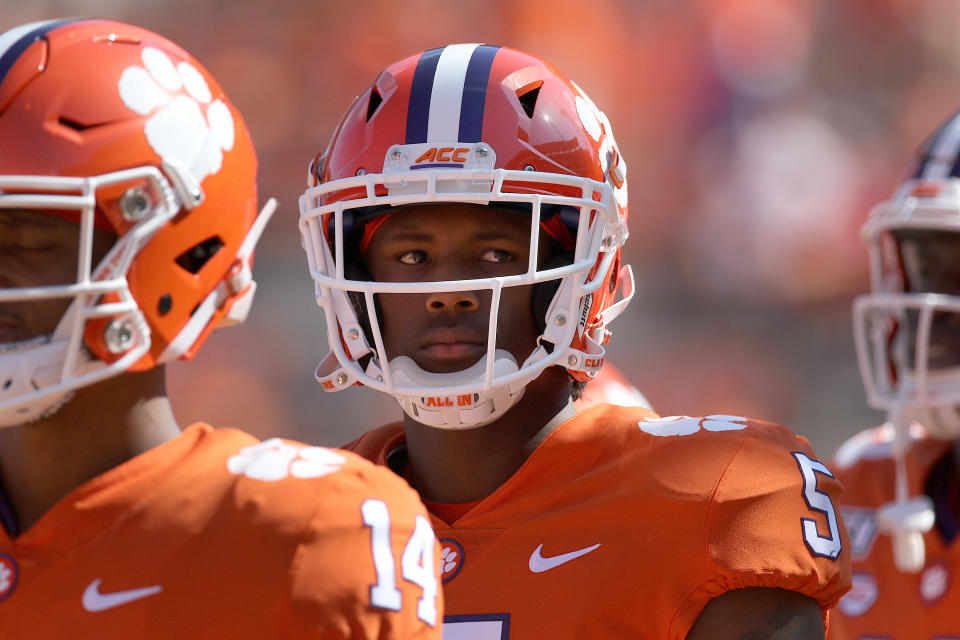Amid NFL draftees' best moments, why did ESPN's graphics showcase their worst?
Over the weekend, the 2020 NFL draft saw 255 young men selected by teams, a huge first step in their dream of becoming professional football players.
But if you watched the events on television, you might have noticed the on-screen graphics got a little ... graphic.
Every player has hurdles to overcome to make it to the NFL. The minuscule odds of being drafted — according to a 2013 study, it’s around 0.08 percent (or 8/10,000) of football-playing high school seniors who are drafted by an NFL team — underscore the incredible difficulty of making it even to this point.
The men whose names were submitted for selection last weekend should be celebrated for that, even if they never suit up in a regular-season game.
Some of their backgrounds and the things they were able to overcome are a huge part of their story. Tua Tagovailoa, for example, endured a potentially devastating hip injury, underwent surgery, embarked upon a long rehab process and was chosen fifth overall by Miami on Thursday night. That’s important.
Shaquem Griffin being born without his left hand is germane to his ability as a football player.
Tee Higgins’ mother and her battle against drug addiction for years is not.

On Friday, Higgins, a standout at Clemson last fall, was drafted by the Cincinnati Bengals with the first pick in the second round. ESPN’s “Get to Know” graphic alongside Higgins’ headshot included this: “Mom, Camilia, fought drug addiction for 16 years.”
Come again?
ESPN has since apologized, with draft producer Seth Markman saying the graphic “should not have aired.” Higgins tweeted that he was proud of his mother for turning her life around; she’s been sober for a decade.
I’m proud of my mom for turning her life around for me and my sister! I have no problem with them showing the world that my mom is a true fighter🖤🙏🏾 https://t.co/11xKrf4wlV
— Tee Higgins⁵ (@teehiggins5) April 26, 2020
The Higgins moment was the nadir of a broadcast that focused heavily on backstories that ranged from difficult to devastating, as if to signal to viewers, “You think being stuck inside because of the coronavirus is bad? Look what these kids overcame!”
The box for Colorado receiver Laviska Shenault Jr. told us his mother survived West Nile virus in 2012. The box for Alabama cornerback Trevon Diggs told us his father died of heart failure in 2008. On it went, much of the sports world introduced to these young men through some of their worst moments instead of their best.
It was exploitative, at a moment when the simple act of watching the draft was more than enough for sports-starved viewers, some of whom would watch a rock-paper-scissors tournament at this point if it gave them someone to root for and against (and let’s be honest, wager some money, too).
Fans watching and using Twitter certainly took notice, with some calling it “tragedy porn.”
One enterprising tweeter, @FitzGSN_, made his own set of graphics, these based on the strengths and struggles of comic book heroes.
Of King T’Challa, also known as the Black Panther, he wrote:
Highest Sparq score in draft history
Some scouts believe he should transition to WR (All-American QB all four years in college)
Saw father killed in terrorist attack; mentor stabbed to death in front of him
It was a creative way to make light of an odd, almost uncomfortable situation.
Markman told the Associated Press that ESPN “puts a huge emphasis on storytelling,” and there’s certainly a great deal of value in knowing a bit more of these young men as human beings. But it was out of place to have their moment in the sun sullied by the mention of something that was completely out of their hands in almost every case.
There’s time to go in-depth on Higgins and his mother at some point, to highlight her battle with addiction, the impact it might have had on Higgins, and how she fought to get better, for herself and for her children. Without knowing if and when NFL training camps will open, and with the regular season up in the air, all there is right now is time to create features on some of the dozens of players who were drafted. They might not be as slickly produced as we’re used to — Zoom video isn’t exactly high-def — but the stories can still be told.
Beyond that, a player shouldn’t require a heart-wrenching story to be considered interesting. We don’t have to highlight poverty and drug addiction and death. These men are now NFL players, an exclusive group.
Another thing to keep in mind: Some players might not want the worst details of their family’s lives to become public knowledge. If it’s not relevant to their ability to play football and contribute to a franchise and they want to keep it private, it’s not really our business. It’s their story to tell.
Higgins wrote a piece earlier this month for The Players Tribune about his relationship with his mother and her journey to sobriety, the day he found out she’d been shot by a drug dealer, and the comfort he found in his grandmother, who lived just a couple of doors down. Higgins (and presumably his mother) are comfortable discussing it. It’s their story to tell.
But one line in a graphic, out of context, doesn’t come close to explaining it all.
More from Yahoo Sports:


